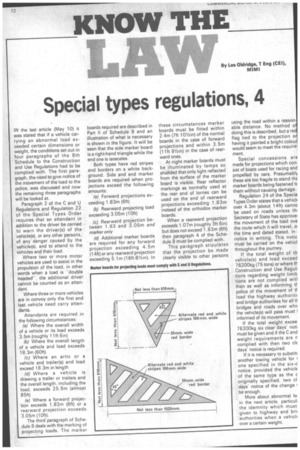Special types regulations, 4
Page 74

If you've noticed an error in this article please click here to report it so we can fix it.
By Les Oldridge, T Eng (CE I). MIMI IN the last article (May 10) it was stated that if a vehicle carrying an abnormal load exceeded certain dimensions or weight, the conditions set out in four paragraphs of the 8th Schedule to the Construction and Use Regulations had to be complied with. The first paragraph, the need to give notice of the movement of the load to the police, was discussed and now the remaining three paragraphs will be looked at.
Paragraph 2 of the C and U Regulations and Regulation 22 of the Special Types Order requires that an attendant in addition to the driver be carried to warn the driver(s) of the vehicle(s), or any other persons,' of any danger caused by the vehicle(s), and to attend to the vehicles and their load.
Where two or more motor vehicles are used to assist in the propulsion of the load, in other words when a load is -double headed-, the additional driver cannot be counted as an attendant.
Where three or more vehicles are in convoy only the first and last vehicle need carry attendants.
Attendants are required in the following circumstances: (a) Where the overall width of a vehicle or its load exceeds 3.5m (roughly lift 6in) (b) Where the overall length of a vehicle and load exceeds 18.3m (60ft) lc,) Where an artic or a vehicle and trailer(s) and load exceed 18.3m in length (d) Where a vehicle is drawing a trailer or trailers and the overall length, including the load, exceeds 25.9m (almost 85ft) (e) Where a forward projection exceeds 1.83m (61t) or a rearward projection exceeds 3.05m (10ft).
The third' paragraph of Schedule 8 deals with the marking of projecting loads. The marker boards required are described in Part ll of Schedule 8 and an illustration of what is necessary is shown in the figure. It will be seen that the side marker board is a right-hand triangle while the end one is isosceles.
Both types have red stripes and borders on a white background. Side and end marker boards are required when projections exceed the following amounts: (a)_ Forward projections exceeding 1.83m (6ft) (b) Rearward projecting load exceeding 3.05m (10ft) (c) Rearward projection between 1.83 and 3.05m end marker only (d) Additional marker boards are required for any forward projection exceeding 4.5m (14ft) or any rearward projection exceeding 5.1m (16ft 81/2in). In these circumstances marker boards must be fitted within 2.4m (7ft 101/2in) of the normal boards in the case of forward projections and within 3.5m (lift 91/2in) in the case of rearward ones.
At night marker boards must be illuminated by lamps so shielded that only light reflected from the surface of the marker board is visible. Rear reflector markings as normally used at the rear end of lorries can be used on the end of rearward projections exceeding 1.83m instead of the orthodox marker boards.
When a rearward projection exceeds 1.07m (roughly 3ft 6in) but does not exceed 1.83m (6ft) then paragraph 4 of the Schedule 8 must be complied with.
This paragraph stipulates that the projection be made clearly visible to other persons using the road within a reasonable distance. No method o doing this is described, but a red flag tied to the projection o having it painted a bright colour would seem to meet the require ment.
Special concessions are made for projections which consist of boats used for racing and propelled by oars. Presumably these are too fragile to stand thE marker boards being fastened tc them without causing damage.
Regulation 24 of the Specia Types Order states that a vehick over 4.3m (about 14ft) canno be used on roads unless thi Secretary of State has approves the movement of the load ove the route which it will travel, o; the time and dated stated, in notice in writing. This notic must be carried on the vehicl throughout the journey.
If the total weight of th vehicle(s) and load exceed 76200kg (75 tons) or where th Construction and Use Reguh tions regarding weight limit; tions are not complied witl then as well as informing th police of the movement of tf load the highway authoritis and bridge authorities for all tl bridges and roads over whis the vehicle(s) will pass must I informed of its movement.
If the total weight excee 76200kg six clear days' noti must be given and if the C and weight requirements are n complied with then two clE days' notice is required.
If it is necessary to substiti another towing vehicle for 1 one specified in the six-d notice, provided the vehicle of the same type as the c originally specified, two cl days' notice of the change be enough.
More about abnormal la in the next article, particul the idemnity which must given to highway and bris authorities when a vehicls over a certain weight.




































































































































